- The Magazine
- Stay Curious
- The Sciences
- Environment
- Planet Earth

What Are Wormholes, and Could They Be the Answer to Time Travel?
Wormholes, cosmic tunnels also known as einstein-rosen bridges, are a staple of science fiction. could they allow real-world humans to travel back in time.

The sci-fi landscape is littered with wormholes. From Douglas Adam's Hitchhiker's Guide to the Galaxy and Rick and Morty to the Marvel Cinematic Universe, these theoretical constructs allow characters to zip between distant points in the universe as easy as stepping through a doorway.
An Einstein-Rosen bridge is the simplest kind of wormhole. And while it can, in theory, allow you to meet a new friend from a distant part of the universe, there are some important reasons why it won’t let you travel back in time.
Black Holes, White Holes and Wormholes
Let’s start with everybody’s favorite astronomical mystery: a black hole . Despite their fearsome reputation, they’re actually rather simple creature. They have a point of infinite density, known as the singularity, in their centers. They are surrounded by a boundary called the event horizon.
The event horizon doesn’t exist in the same way that the surface of a planet exists. Instead it’s just a mathematical line in the sand that tells you one thing: if you cross within that special distance, you’re trapped forever, because you’ll have to travel faster than the speed of light to escape.
Read More: 'Fuzzballs' Might Be the Answer to a Decades-Old Paradox About Black Holes
And that’s it. That’s a black hole. A singularity and an event horizon. All things that cross the event horizon will never escape back into the universe – things go in and never come out.
Mathematically we can also define the polar opposite of a black hole, which is conveniently called a white hole. White holes also have a singularity, but their event horizons act differently. Anything already on the outside of a white hole (like, the entire universe) can never, ever cross within it, no matter how hard it tries. And anything already inside the white hole will find itself ejected from it faster than the speed of light.
Now when we take a black hole and a white hole and connect their singularities together, we get an entirely new kind of object: an Einstein-Rosen bridge , better known as a wormhole.
Read More: Astronomers Found a Baffling Black Hole That Existed 13 Billion Years Ago
What Is a Wormhole?
Wormholes are essentially hollow tubes through space and time that can connect very distant regions of the universe. A star may be thousands of light-years away, but a wormhole can connect that star to us with a tunnel only a few steps long.
Wormholes also have the somewhat mystical ability to allow backwards time travel. If you take one end of the wormhole and accelerate it to a speed close to that of light, it will experience time dilation — its internal “clock” will run slower than the rest of the universe.
That will cause the two ends of the wormhole to no longer be synchronized in time. Then you could walk in one end and end up in your own past. Voilà: time travel.
Read More: Is There a Particle That Can Travel Back in Time?
Can Humans Travel Through Wormholes?
There's just one, tiny, teensy problem with this setup: Einstein-Rosen bridges are indeed wormholes, but the entrance to the wormhole sits behind the black hole event horizon. And the number one rule of black hole event horizons is that once you cross them, you’re never allowed to escape. Ever.
Once you pass through a black hole event horizon, you are forced towards the singularity, where you are guaranteed to meet your gruesome end. In other words, once you enter an Einstein-Rosen bridge, you will never escape.
So, the unfortunate truth with Einstein-Rosen bridges is that while they appear to be magical doorways to distant reaches of the universe, they are just as deadly as black holes. When you enter you can meet other travelers who have fallen in from the other side, and you could even carry on a conversation…briefly, before you both struck the singularity.
There have been attempts to stabilize Einstein-Rosen bridges and make them traversable by somehow getting their entrances to sit outside the event horizon. So far the only way we know how to do this is with exotic matter. If you threaded the wormhole tunnel with matter that had negative mass, then in principle you could have a not-deadly-at-all wormhole.
Alas, negative matter does not appear to exist in the universe, and so our wormhole — and time travel — dreams will have to remain as mere mathematical fantasies.
Read More: What Did Einstein's Theories Say About the Illusion of Time?
- space exploration
Already a subscriber?
Register or Log In

Keep reading for as low as $1.99!
Sign up for our weekly science updates.
Save up to 40% off the cover price when you subscribe to Discover magazine.
This page has been archived and is no longer updated

The Missing Piece: Are Wormholes the Key to Time Travel?

Time travel -- it's a concept we're all too familiar with. From Hollywood Movies (shout out to Back to the Future) to theoretical physics, many theories have circulated regarding the bewildering topic of time travel. However, recently students at the California Institute of Technology1 have shed new light on a relatively dated theory: that wormholes may be the missing piece in the seemingly unsolvable puzzle behind time travel. So, step aside Doc Brown, because we're going to explore how a unique and mysterious part of our universe- the wormhole- connects to traveling through time!
Just like many principles in Physics, this concept finds its base in Einstein's Theory of General Relativity (for some background on this topic, view our previous blog post, "What happens to Matter inside a Black Hole?"). Basically, the theory attributes the characteristics of a wormhole to its incredibly high velocity. Similar to a black hole, a wormhole would compress an entering object to the size of a singularity and accelerate it to immeasurable speeds through the "throat" of the wormhole to the other side of the funnel. So, for now, think of a wormhole as a black hole that has a start and end point.2
Now, this is where the physics becomes complex. We know that a wormhole can basically "teleport" compressed objects at super speeds from one end to another, but how does that explain the time travel aspect? Well, the concept of time dilation can explain that. Time dilation is the relative difference in the passage of time between two entities due to a stark difference in either gravity or relative velocity. In the case of the wormhole, both are in play, which only compounds the effects. For a tangible example to grasp, let's look to the astronauts aboard the International Space Station. After 6 months aboard the ISS (where there is less gravity, but greater velocity of movement), these astronauts have actually aged .007 seconds less than the crew stationed on Earth.3 While this seems insignificant, we have to remember that because the velocity is increased but the gravity is decreased, each is actually mitigating the effects of the other. However, in a wormhole, where the effects of both gravity and velocity are exponentially amplified AND working in tandem, their relativistic effects are enormous.4
This graphic portrays an accurate depiction of velocities' effect on time dilation: http://upload.wikimedia.org/wikipedia/commons/7/72/Nonsymmetric_velocity_time_dilation.gif
Now that we have an understanding of time dilation, we want to leave you with this example. Imagine two test subjects at each side of a wormhole in the year 1995. One mouth of the wormhole has been accelerated to a point where relativistic effects (i.e. time dilation) apply significantly and the other mouth is stationary. When the two subjects pass through their respective mouths, they end up at where their counterpart stood... but at different times! The accelerated mouth would land its test subject in, let's say, 2000. However, the stationary mouth would place its test subject in a later year - we'll call it 2005- since the accelerated mouth exists in a different time caused by time dilation. The time travel becomes evident when we consider the following: what if the test subject who landed in 2005 stepped back into the mouth? They would end up in the year 2000, or 5 years in the past! A bit of manipulation, therefore, could technically transport this subject to any point in time between 2000 and 2005.5
Unfortunately, scientists have been unable to totally grasp how we could adapt the power of a wormhole into time machine-esq technology. We have yet to even theorize how we could accelerate a wormhole to relativistic speeds. Given that this is another theoretical aspect of our known universe, testing is extremely limited and all postulates have very little opportunity for tangible proof. What is certain, though, is that the advances we've made thus far in the field have brought us several pieces closer to solving the time traveler's puzzle!


Email your Friend
- January 23, 2014 The Search for the God Particle
- January 21, 2014 Can We Make the Jump?
- September 07, 2013 An Enlightening View of Solar Eclipses
- September 02, 2013 Sunny Side Down: The Future Destruction of the Sun
- August 28, 2013 The Missing Piece: Are Wormholes the Key to Tim...
- July 30, 2013 What Happens to Matter Inside a Black Hole?
© 2014 Nature Education
- Press Room |
- Terms of Use |
- Privacy Notice |


Is time travel even possible? An astrophysicist explains the science behind the science fiction
Assistant Professor of Astronomy and Astrophysics, University of Maryland, Baltimore County
Disclosure statement
Adi Foord does not work for, consult, own shares in or receive funding from any company or organisation that would benefit from this article, and has disclosed no relevant affiliations beyond their academic appointment.
University of Maryland, Baltimore County provides funding as a member of The Conversation US.
View all partners

Curious Kids is a series for children of all ages. If you have a question you’d like an expert to answer, send it to [email protected] .
Will it ever be possible for time travel to occur? – Alana C., age 12, Queens, New York
Have you ever dreamed of traveling through time, like characters do in science fiction movies? For centuries, the concept of time travel has captivated people’s imaginations. Time travel is the concept of moving between different points in time, just like you move between different places. In movies, you might have seen characters using special machines, magical devices or even hopping into a futuristic car to travel backward or forward in time.
But is this just a fun idea for movies, or could it really happen?
The question of whether time is reversible remains one of the biggest unresolved questions in science. If the universe follows the laws of thermodynamics , it may not be possible. The second law of thermodynamics states that things in the universe can either remain the same or become more disordered over time.
It’s a bit like saying you can’t unscramble eggs once they’ve been cooked. According to this law, the universe can never go back exactly to how it was before. Time can only go forward, like a one-way street.
Time is relative
However, physicist Albert Einstein’s theory of special relativity suggests that time passes at different rates for different people. Someone speeding along on a spaceship moving close to the speed of light – 671 million miles per hour! – will experience time slower than a person on Earth.
People have yet to build spaceships that can move at speeds anywhere near as fast as light, but astronauts who visit the International Space Station orbit around the Earth at speeds close to 17,500 mph. Astronaut Scott Kelly has spent 520 days at the International Space Station, and as a result has aged a little more slowly than his twin brother – and fellow astronaut – Mark Kelly. Scott used to be 6 minutes younger than his twin brother. Now, because Scott was traveling so much faster than Mark and for so many days, he is 6 minutes and 5 milliseconds younger .
Some scientists are exploring other ideas that could theoretically allow time travel. One concept involves wormholes , or hypothetical tunnels in space that could create shortcuts for journeys across the universe. If someone could build a wormhole and then figure out a way to move one end at close to the speed of light – like the hypothetical spaceship mentioned above – the moving end would age more slowly than the stationary end. Someone who entered the moving end and exited the wormhole through the stationary end would come out in their past.
However, wormholes remain theoretical: Scientists have yet to spot one. It also looks like it would be incredibly challenging to send humans through a wormhole space tunnel.
Paradoxes and failed dinner parties
There are also paradoxes associated with time travel. The famous “ grandfather paradox ” is a hypothetical problem that could arise if someone traveled back in time and accidentally prevented their grandparents from meeting. This would create a paradox where you were never born, which raises the question: How could you have traveled back in time in the first place? It’s a mind-boggling puzzle that adds to the mystery of time travel.
Famously, physicist Stephen Hawking tested the possibility of time travel by throwing a dinner party where invitations noting the date, time and coordinates were not sent out until after it had happened. His hope was that his invitation would be read by someone living in the future, who had capabilities to travel back in time. But no one showed up.
As he pointed out : “The best evidence we have that time travel is not possible, and never will be, is that we have not been invaded by hordes of tourists from the future.”
Telescopes are time machines
Interestingly, astrophysicists armed with powerful telescopes possess a unique form of time travel. As they peer into the vast expanse of the cosmos, they gaze into the past universe. Light from all galaxies and stars takes time to travel, and these beams of light carry information from the distant past. When astrophysicists observe a star or a galaxy through a telescope, they are not seeing it as it is in the present, but as it existed when the light began its journey to Earth millions to billions of years ago.
NASA’s newest space telescope, the James Webb Space Telescope , is peering at galaxies that were formed at the very beginning of the Big Bang, about 13.7 billion years ago.
While we aren’t likely to have time machines like the ones in movies anytime soon, scientists are actively researching and exploring new ideas. But for now, we’ll have to enjoy the idea of time travel in our favorite books, movies and dreams.
Hello, curious kids! Do you have a question you’d like an expert to answer? Ask an adult to send your question to [email protected] . Please tell us your name, age and the city where you live.
And since curiosity has no age limit – adults, let us know what you’re wondering, too. We won’t be able to answer every question, but we will do our best.
- Time travel
- Special Relativity
- Thermodynamics
- Stephen Hawking
- Curious Kids
- Curious Kids US
- Time travel paradox

Faculty of Law - Academic Appointment Opportunities

Operations Manager

Senior Education Technologist

Audience Development Coordinator (fixed-term maternity cover)

Lecturer (Hindi-Urdu)
We have completed maintenance on Astronomy.com and action may be required on your account. Learn More

- Login/Register
- Solar System
- Exotic Objects
- Upcoming Events
- Deep-Sky Objects
- Observing Basics
- Telescopes and Equipment
- Astrophotography
- Space Exploration
- Human Spaceflight
- Robotic Spaceflight
- The Magazine
If wormholes exist, could we really travel through them?

But wormholes also present the perfect way for writers to get around that pesky speed of light, the universe’s speed limit and impediment to fast travel through the cosmos. If characters in science fiction aren’t taking months or years to travel between worlds, a wormhole is likely the reason.
Too bad, then, that as far as we know, the things don’t exist.
Bringing the universe to your door. We’re excited to announce Astronomy magazine’s new Space and Beyond subscription box – a quarterly adventure, curated with an astronomy-themed collection in every box. Learn More >> . Historical Holes
Oh, wormholes could exist. We just don’t know whether they actually do . Or, for that matter, if they’d be useful to us as potential shortcuts.
But ever since Albert Einstein published his general theory of relativity , we’ve had the mathematical language for describing and imagining these fantastical structures . Back then, though, scientists referred to them as “one-dimensional tubes” and simply “bridges” — in fact, the term “ Einstein-Rosen bridge ” is still used semi-interchangeably with “wormhole” (the “Rosen” being Israeli physicist Nathan Rosen ).
It was American physicist John Wheeler who coined the vermicular vernacular in a 1957 Annals of Physics paper : “This analysis forces one to consider situations,” he wrote, “where there is a net flux of lines of force, through what topologists would call ‘a handle’ of the multiply-connected space, and what physicists might perhaps be excused for more vividly terming a ‘wormhole’.”
Tantalizing Physics
It’s a lucky thing, because that vivid name helps describe just what the heck we’re talking about. The curvature of space and lines of force might not mean much to most people, but who can’t imagine a worm eating its way through an apple or piece of timber? The resulting tunnel, connecting one part of the surface with another more distant part, is the perfect metaphor for something that can connect otherwise remote locations in the universe.
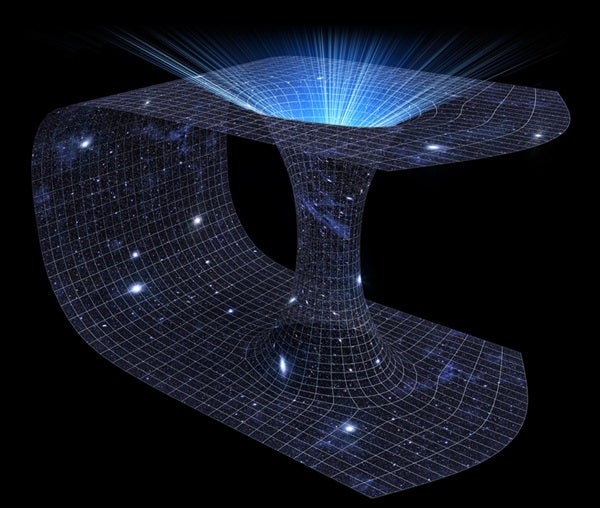
Wormholes, thus, are the perfect way to bypass Einstein’s speed limit, and get your heroes and villains to travel the galaxy in a reasonable time frame. Plus, they allow for the element of time travel to enter the story, all without breaking any laws of physics.
So, the real question is: Can actual people take advantage of wormholes too? The answer is… maybe?
Wither Wormholes?
The first problem for any explorer determined to survey a wormhole is simply finding one. While Einstein’s work says they can exist, we don’t currently know of any. They may actually be impossible after all, forbidden by some deeper physics that the universe obeys, but we haven’t discovered.
The second issue is that, despite years of research, scientists still aren’t really sure how wormholes would work. Can any technology ever create and manipulate them , or are they simply a part of the universe? Do they stay open forever, or are they only traversable for a limited time? And perhaps most significantly, are they stable enough to allow for human travel?
The answer to all of these: We just don’t know.
But that doesn’t mean scientists aren’t working on it. Despite the lack of actual wormholes to study, researchers can still model and test Einstein’s equations. NASA’s conducted legitimate wormhole research for decades , and a team described just this year how wormhole-based travel might be more feasible than previously thought.
That research concerned one of the most popular conceptions of wormholes, with black holes serving as one of the openings. But black holes are famously dangerous , possibly stretching apart anyone who approaches too close. It turns out, though, that some black holes might allow objects to pass through relatively easily. This would allow a traveler to explore the space beyond, and thus eliminate one of the biggest hurdles to entering such a wormhole. But again, that’s only if they exist in the first place.
So, until we either find an actual wormhole to study, or realize that they can’t help us explore the universe, we’ll have to do it the old fashioned way: By taking rockets the long way around, and taking our minds on fictional adventures.

A galaxy’s bright flicker turned out to be two black holes dancing in the night

When did we realize that Earth orbits the Sun?

2024 Full Moon calendar: Dates, times, types, and names

Scientists discover an ancient volcano near the martian equator

An eclipse victory: What it was like at Love Field in Dallas
Nasa’s snake-like eels robot impresses in early testssssssss.
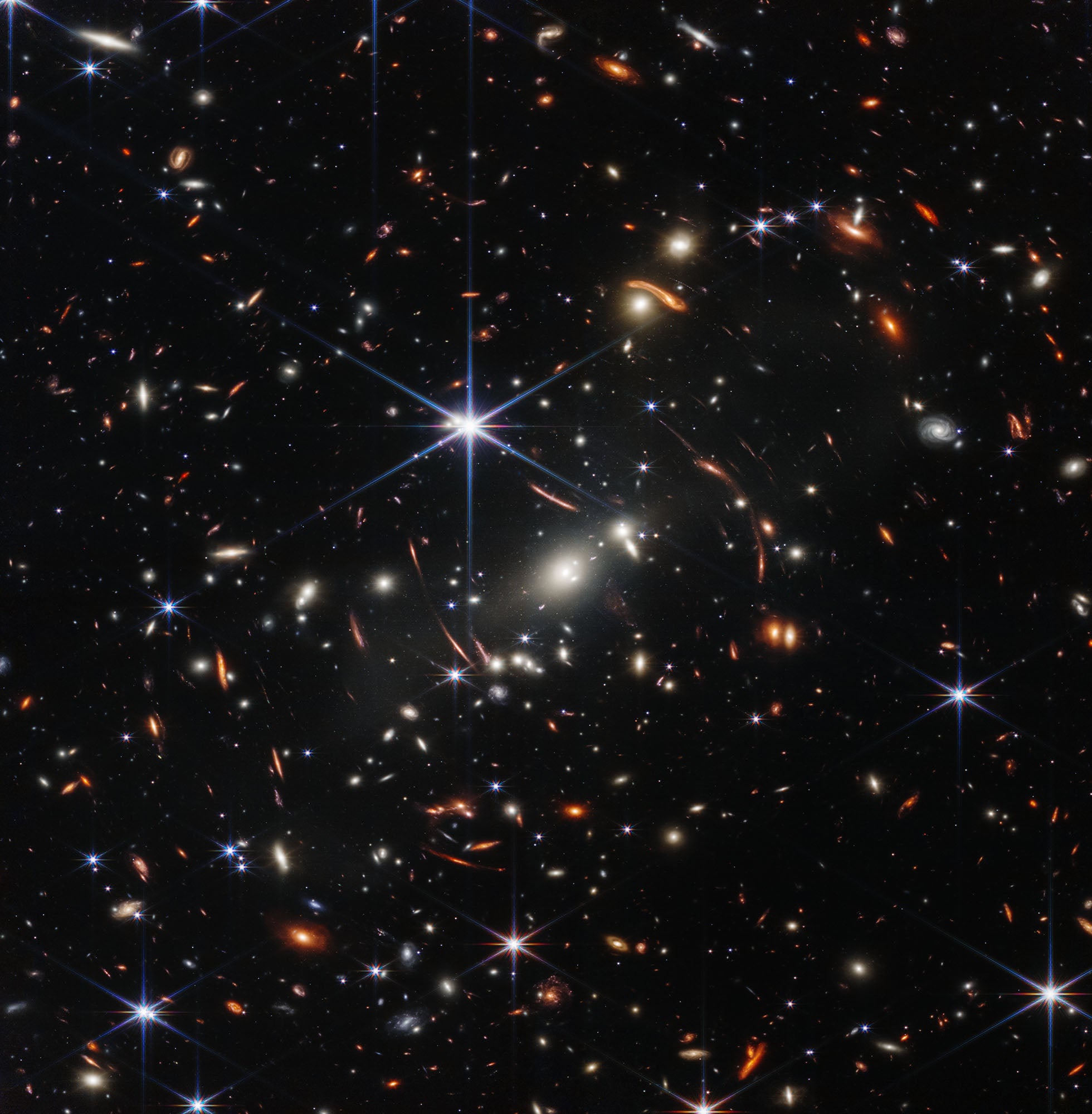
Could a telescope see the beginning of time? An astronomer explains

How to see the next 20 years of eclipses, including the eclipse of a lifetime
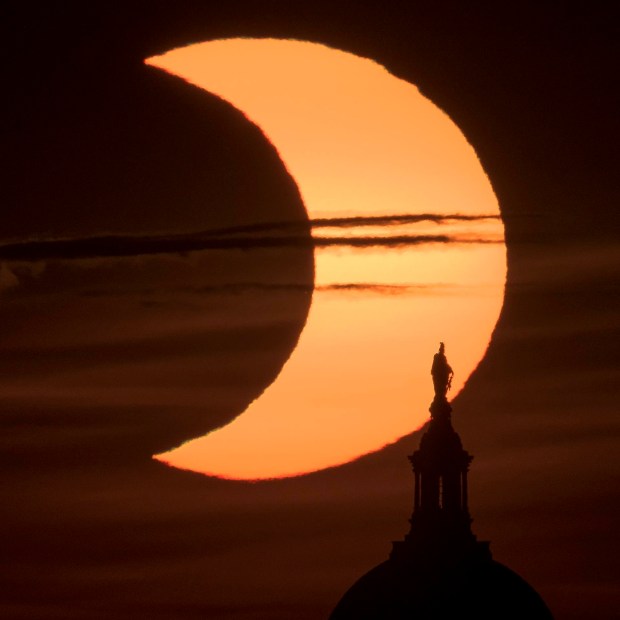
The 10 most important eclipses in history
The hunt for wormholes: How scientists look for space-time tunnels
Wormholes, a science fiction staple, might be real after all.
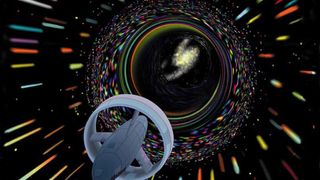
- What is a wormhole?
- Where wormholes exist
- How to find a wormhole
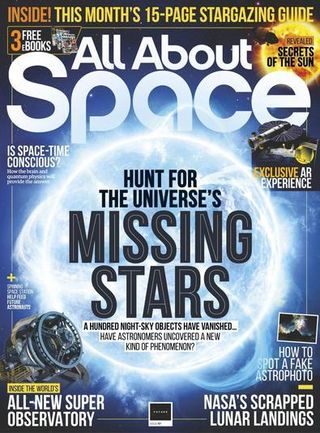
This article is brought to you by All About Space .
All About Space magazine takes you on an awe-inspiring journey through our solar system and beyond, from the amazing technology and spacecraft that enables humanity to venture into orbit, to the complexities of space science.
Wormholes — shortcuts in space and time — have long been a staple of science fiction. But some scientists believe we may soon be able to prove that they are a real part of the universe—as real as the sun and the stars or you and I. The scientific term for this exotic object is an Einstein-Rosen bridge, which is a clue as to where the idea came from.
Wormholes are rooted in Albert Einstein 's general theory of relativity — his groundbreaking masterpiece that turned our ideas about gravity on their head. For centuries we thought we knew how gravity worked, thanks to Isaac Newton . Apples fell to the ground, and Earth stayed in orbit around the sun because of a gravitational pull between the objects. Yet Einstein saw it differently, suggesting that what we experience as gravity is simply a bending of space and time. Under this radical new regime, Earth orbits the sun because our star's mass warps the space around it, much like a bowling ball would warp a bed sheet if it were placed in the center of it. Our planet is simply following the local curvature of this fabric, which Einstein called 'space-time'.
Such a crazy idea was in dire need of experimental evidence to back it up. Crucially, a solar eclipse in 1919 offered just such an opportunity. When the moon blocked out the sun, it was dark enough to see stars close by. Yet we don't see these stars where they really are because the sun's gravity bends their light on its way to us. Newton and Einstein's competing pictures of gravity predicted different amounts of bending, allowing us to see who was right. Einstein came out on top: Massive objects do indeed bend the space-time around them.
What is a wormhole? Space-time tunnels explained
Imagine space as a vast sheet of paper. You live at one end and you want to travel to the other end. Ordinarily you'd have to trudge across the entire length of the page to get there. But what if you folded the paper in half instead? Suddenly, where you are and where you want to be are right next to each other. You simply have to jump that tiny gap. We call these objects wormholes because it is like a worm trying to navigate its way around an apple. To get from the top to the bottom it has two choices: Crawl around the outside, or chew a shortcut through the middle.
Until recently our chances of finding these objects — if they even exist — were slim at best. But that changed in February 2016 when the scientists behind the LIGO (Laser Interferometer Gravitational-Wave Observatory) experiment announced the first-ever detection of gravitational waves . These are tiny ripples in the fabric of space-time, predicted by general relativity, which spread out through the universe much like ripples on a pond. "It was a game-changer," says Vitor Cardoso, a physicist at the University of Lisbon in Portugal.
Two black holes — each about 30 times more massive than the sun — had rammed into each other 1.3 billion years ago. Their violent crash sent a tsunami of gravitational waves roaring out through space-time, eventually reaching the LIGO instrument in September 2015.
Cardoso's research suggests that two colliding wormholes would produce a similar burst of gravitational waves. Excitingly, however, he says the resulting waves would be slightly different, allowing us to distinguish between black holes and wormholes.
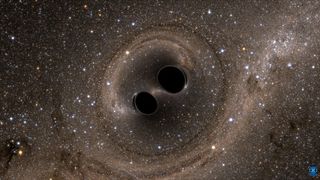
The key here is what's known as the 'ringdown '— the way in which the gravitational waves die away after the initial collision. It's similar to the way the sound of a ringing bell fades over time. "With two colliding wormholes you would see the ringdown—just like you see for black holes—but if your detector is very sensitive then seconds, or tens of seconds, after the main burst you would see something different," he says. This is due to the nature of black holes—gravitational Goliaths that swallow anything that gets too close. The ringdown of colliding black holes always gets quieter, quickly fading away to silence. But with colliding wormholes, after the silence you get an echo—a sudden, late signal as the gravitational waves bounce off the wormholes' surface. You can't get that with black holes as they swallow everything.
Unfortunately, LIGO currently isn't sensitive enough to pick up these late changes. However, researchers are upgrading LIGO's instruments, and it could be possible in "ten years from now or so," Cardoso says. Another exciting project on the horizon is the European Space Agency's ( ESA 's) Laser Interferometer Space Antenna (LISA). This is a gravitational-wave observatory in space that has a tentative launch date of 2034. However, in 2015 the ESA launched LISA Pathfinder—a test mission to develop certain key technologies that are vital for LISA's success. In April 2016, the ESA announced that LISA Pathfinder had indeed shown that LISA was feasible.
But ringdowns of collisions might not be the only route to finding a wormhole. Diego Rubiera-Garcia, Cardoso's former colleague at the University of Lisbon, has another idea. He's been studying what goes on deep inside a black hole. The conventional picture of black holes, as described by general relativity, has all the infalling mass squeezed down into an infinitely small, infinitely dense point—a singularity. "Any observer who approaches this point is destroyed," says Rubiera-Garcia. "After that you will disappear from space-time… there is nowhere else for you to go." It is at this singularity that general relativity breaks down—its equations stop making sense. This leaves many physicists confident that we need a new set of rules to replace general relativity in such an extreme environment.
And that's where wormholes come in. When Rubiera-Garcia applied one of the alternative sets of rules to the physics of black holes, the singularity disappeared, and the mathematics yielded a wormhole in its place. "Then it would be possible for an observer to go through this wormhole and cross to another region of the universe," he says. The trouble is that this shortcut through the cosmos might just be a phantom of the math: The alternative to general relativity that Rubiera-Garcia used to find it might not be how our universe really works. As with all good scientific theories, it needs to be tested, just as Einstein's was in 1919. That's where gravitational waves come back in.
Once we have built up a significant library of gravitational-wave detections, we can trawl through the data looking for departures from what general relativity predicts we should see. If these departures are found—and they match what the alternative theory predicts—it could signify that wormholes do indeed lurk inside black holes. The first detection of gravitational waves has ushered in a new era, one in which we may well find out that wormholes aren't just science fiction after all.
Where scientists think wormholes might exist
Center of the Milky Way
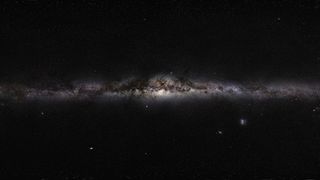
In 2015 Italian researchers suggested there could be a wormhole lurking in the center of the Milky Way some 27,000 light-years away. Ordinarily, a wormhole would need some exotic matter to keep it open, but researchers believe dark matter might be doing the job.
Quantum foam

Even empty space isn't truly empty—on the smallest scales it is a cauldron of bubbling energy popping in and out of existence. Some think fleeting virtual black holes may be being created all the time in this 'quantum foam'. However, we'd need a lot of energy if we wanted to make one permanent.
Inside a black hole

Rather than having a singularity at the center, as general relativity predicts, some researchers believe we'd find a wormhole. However, the jury is still out on whether it would be big enough for a human to traverse.
How do we know if we've found a wormhole?
Gravitational-wave ringdown echo
The gravitational waves from colliding black holes die away very quickly, but two colliding wormholes would produce an echo detectable with the next generation of experiments.
Microlensing

If a wormhole passed in front of a distant star, it would bend the star's light slightly in an event called 'microlensing'. This technique has already been used to find rogue planets.
Heading into one
Some scientists believe that black holes are actually wormholes in disguise. It's a risky endeavor, but sending something into one would let us know for certain if wormholes really do exist.
Follow us on Twitter @Spacedotcom or Facebook.
Join our Space Forums to keep talking space on the latest missions, night sky and more! And if you have a news tip, correction or comment, let us know at: [email protected].
Get the Space.com Newsletter
Breaking space news, the latest updates on rocket launches, skywatching events and more!

Colin Stuart is an award-winning astronomy author, speaker and tutor based in the UK. His popular science books have sold over 400,000 copies worldwide and have been translated into 21 languages. The asteroid (15347) Colinstuart is named after him and he runs an online Astrophysics for Beginners course and a science writing course .
Car-size asteroid gives Earth a super-close shave with flyby closer than some satellites
SpaceX launches advanced weather satellite for US Space Force (video)
ULA chronicles the rise of Vulcan rocket in new employee-drawn comic book
Most Popular
- 2 Watch an exclusive clip from the CNN' 'Space Shuttle Columbia: The Final Flight' finale (video)
- 3 'Fly Me to the Moon' trailer mixes real-life Apollo history with moon landing hoax
- 4 HALO Space unveils capsule design for stratospheric space 'glamping'
- 5 One of the universe's most 'extreme' dead stars just sprang back to life unexpectedly
Scientists Have Determined How to Travel Back in Time With a Ring Wormhole
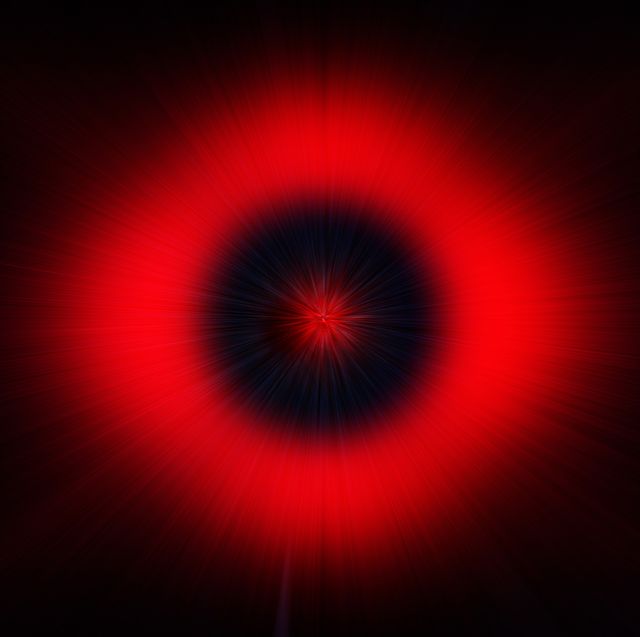
Gear-obsessed editors choose every product we review. We may earn commission if you buy from a link. Why Trust Us?
- A recent study claims to have calculated a potential method of time travel.
- It involves a highly theoretical object called a “ring wormhole,” which is a type of wormhole that connects two regions of space, like a portal.
- Ring wormholes had previously been theorized to be portals to other universes, and researchers now propose they could act as time machines as well.
But that hasn’t stopped scientists from trying to figure out how we maybe could, someday, jump around out of order in the time stream. And recently, a team of theoretical physicists published a paper on exactly what laws of physics could be stretched just far enough to make it happen.
The key to the whole idea is wormholes —specifically, a type of wormhole called a ring wormhole. Now, wormholes are already entirely theoretical, so this discussion is going to get weird. And ring wormholes get even weirder than “normal” wormholes.
Your average, run-of-the-mill wormholes, as we tend to think of them, are basically holes punched in the fabric of spacetime by the immense gravity of black holes. The gravity well at the center of these objects is so intense that scientists have often theorized they could act as tunnels to another universe , or another time.
But ring wormholes aren’t black-hole dependent. Instead, the (again, highly theoretical) objects are caused by circles of mass that have negative energy, something only made possible by the strange effects of the quantum realm . This circle of negative energy would basically create a portal to another universe without the need to go through a black hole tunnel.
“You could go through and not even notice that you went to another universe,” Andrei Zelnikov, one of the authors on the recent paper, told New Scientist .
The paper —published in the journal Physical Review D by Zelnikov and his team—puts forth calculations that claim a ring wormhole could not only act as a universe-to-universe teleport, but as a time machine .
According to the heavy-duty number-crunching, the ring wormholes could generate something called a “closed timelike curve” if one “mouth” of the wormhole near a bunch of mass and the other “mouth” was far away from any significant amount of mass . If the conditions are right around the mouths of the wormhole, the closed timelike curves generated are then able to turn a portal into a time machine.
“The time machine is a natural consequence of the wormhole existing,” Toby Wiseman, a professor of theoretical physics at the Imperial College London who was not a part of the study, told New Scientist . “Apart from the crazy matter that makes up the wormhole, there’s nothing too wild being postulated here, and then the consequence is something even more crazy.”
You can decide for yourself if proposing a method for time travel is “too wild.” But wild or not, scientists remain dedicated to truly understanding all of the laws of time and space —and exactly how we can bend them to make the coolest things possible.
Jackie is a writer and editor from Pennsylvania. She's especially fond of writing about space and physics, and loves sharing the weird wonders of the universe with anyone who wants to listen. She is supervised in her home office by her two cats.

.css-cuqpxl:before{padding-right:0.3125rem;content:'//';display:inline;} Science .css-xtujxj:before{padding-left:0.3125rem;content:'//';display:inline;}

A Section of the San Andreas Fault Is Waking Up

Scientists Found a Lynx Skeleton Layered With Dogs

A Desert Dig Has Revealed an Ancient Campsite
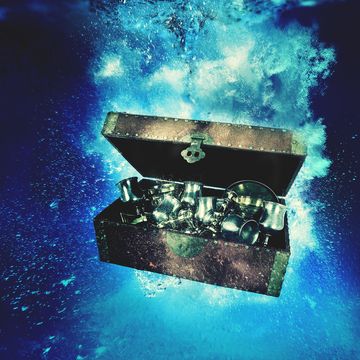
A Crew Is Extracting the Holy Grail of Shipwrecks

Two New Fossils Unlock Mammal Mysteries
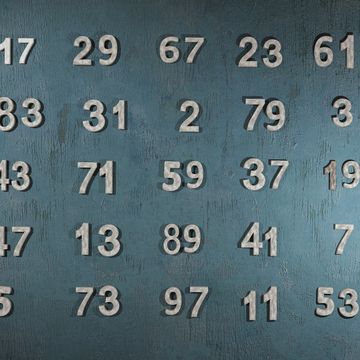
A Prime Numbers Study Is Stirring Up Controversy
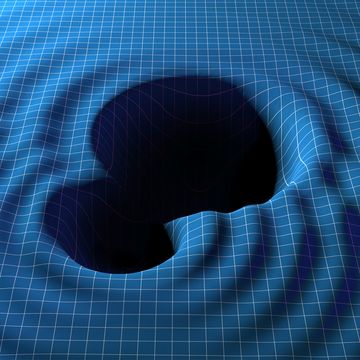
Our Existence May Hinge on Gravitational Waves

Cloud Structure Key to World’s Cleanest Air

The Truth About Walt Disney’s Frozen Head

Climate Change Can Wreck a Tree’s Circadian Rhythm

Company Pauses Gene-Editing Due to Side Effects

Is time travel even possible? An astrophysicist explains the science behind the science fiction
Published: Nov 13, 2023
By: Magazine Editor
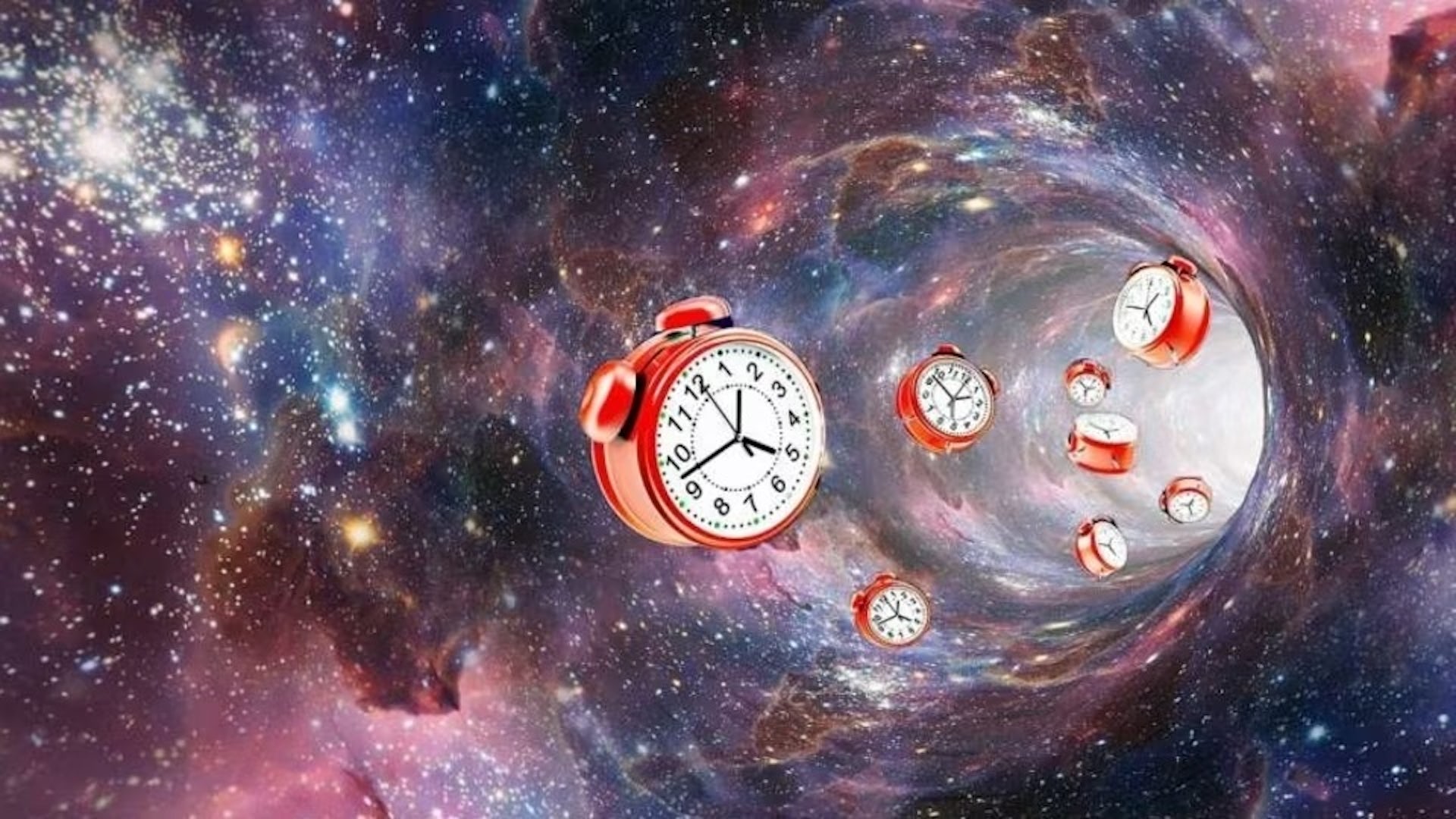
Written by Adi Foord , assistant professor of physics , UMBC
Curious Kids is a series for children of all ages. If you have a question you’d like an expert to answer, send it to [email protected] .
Will it ever be possible for time travel to occur? – Alana C., age 12, Queens, New York
Have you ever dreamed of traveling through time, like characters do in science fiction movies? For centuries, the concept of time travel has captivated people’s imaginations. Time travel is the concept of moving between different points in time, just like you move between different places. In movies, you might have seen characters using special machines, magical devices or even hopping into a futuristic car to travel backward or forward in time.
But is this just a fun idea for movies, or could it really happen?
The question of whether time is reversible remains one of the biggest unresolved questions in science. If the universe follows the laws of thermodynamics , it may not be possible. The second law of thermodynamics states that things in the universe can either remain the same or become more disordered over time.
It’s a bit like saying you can’t unscramble eggs once they’ve been cooked. According to this law, the universe can never go back exactly to how it was before. Time can only go forward, like a one-way street.
Time is relative
However, physicist Albert Einstein’s theory of special relativity suggests that time passes at different rates for different people. Someone speeding along on a spaceship moving close to the speed of light – 671 million miles per hour! – will experience time slower than a person on Earth.
People have yet to build spaceships that can move at speeds anywhere near as fast as light, but astronauts who visit the International Space Station orbit around the Earth at speeds close to 17,500 mph. Astronaut Scott Kelly has spent 520 days at the International Space Station, and as a result has aged a little more slowly than his twin brother – and fellow astronaut – Mark Kelly. Scott used to be 6 minutes younger than his twin brother. Now, because Scott was traveling so much faster than Mark and for so many days, he is 6 minutes and 5 milliseconds younger .
Some scientists are exploring other ideas that could theoretically allow time travel. One concept involves wormholes , or hypothetical tunnels in space that could create shortcuts for journeys across the universe. If someone could build a wormhole and then figure out a way to move one end at close to the speed of light – like the hypothetical spaceship mentioned above – the moving end would age more slowly than the stationary end. Someone who entered the moving end and exited the wormhole through the stationary end would come out in their past.
However, wormholes remain theoretical: Scientists have yet to spot one. It also looks like it would be incredibly challenging to send humans through a wormhole space tunnel.
Paradoxes and failed dinner parties
There are also paradoxes associated with time travel. The famous “ grandfather paradox ” is a hypothetical problem that could arise if someone traveled back in time and accidentally prevented their grandparents from meeting. This would create a paradox where you were never born, which raises the question: How could you have traveled back in time in the first place? It’s a mind-boggling puzzle that adds to the mystery of time travel.
Famously, physicist Stephen Hawking tested the possibility of time travel by throwing a dinner party where invitations noting the date, time and coordinates were not sent out until after it had happened. His hope was that his invitation would be read by someone living in the future, who had capabilities to travel back in time. But no one showed up.
As he pointed out : “The best evidence we have that time travel is not possible, and never will be, is that we have not been invaded by hordes of tourists from the future.”
Telescopes are time machines
Interestingly, astrophysicists armed with powerful telescopes possess a unique form of time travel. As they peer into the vast expanse of the cosmos, they gaze into the past universe. Light from all galaxies and stars takes time to travel, and these beams of light carry information from the distant past. When astrophysicists observe a star or a galaxy through a telescope, they are not seeing it as it is in the present, but as it existed when the light began its journey to Earth millions to billions of years ago. https://www.youtube.com/embed/QeRtcJi3V38?wmode=transparent&start=0 Telescopes are a kind of time machine – they let you peer into the past.
NASA’s newest space telescope, the James Webb Space Telescope , is peering at galaxies that were formed at the very beginning of the Big Bang, about 13.7 billion years ago.
While we aren’t likely to have time machines like the ones in movies anytime soon, scientists are actively researching and exploring new ideas. But for now, we’ll have to enjoy the idea of time travel in our favorite books, movies and dreams.
This article is republished from The Conversation under a Creative Commons license. Read the original article and see more than 250 UMBC articles available in The Conversation.
Tags: CNMS , Physics , The Conversation
Related Posts
- Campus Life
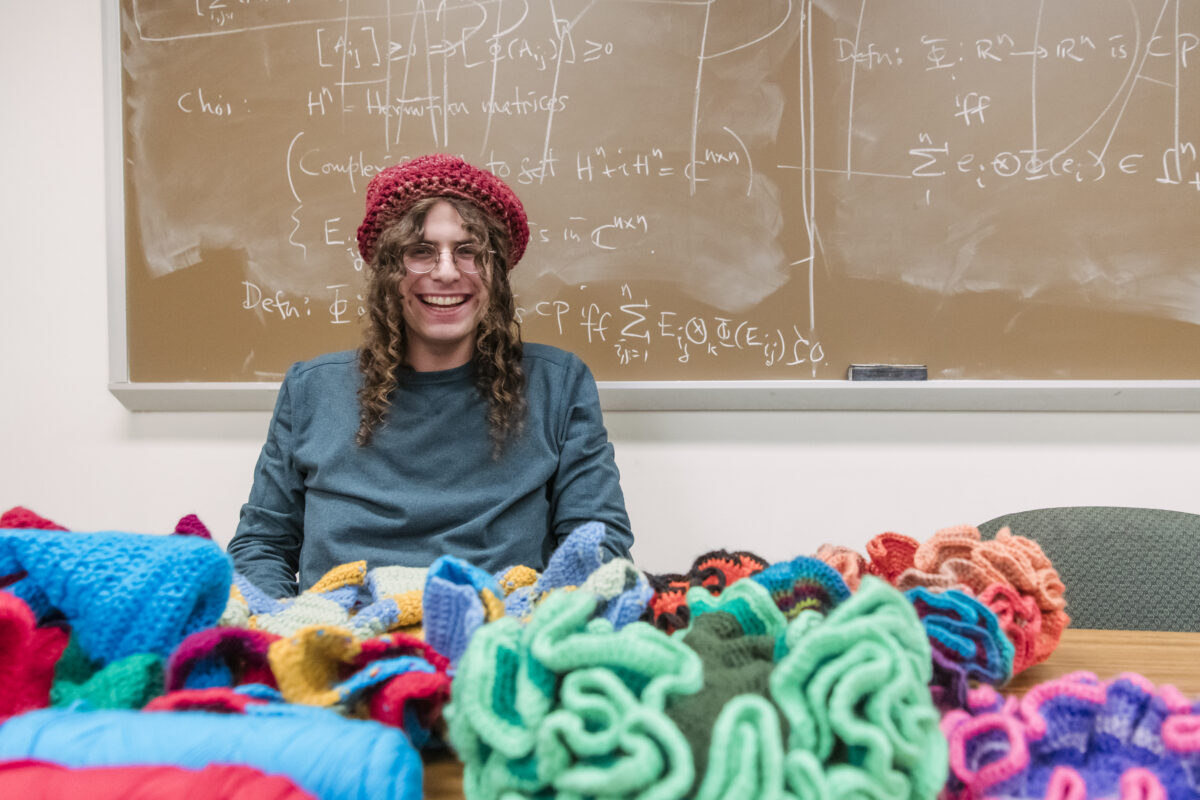
Stitching it all together, or how Ephraim Ruttenberg ’25 got hooked on math and crochet
- Science & Tech
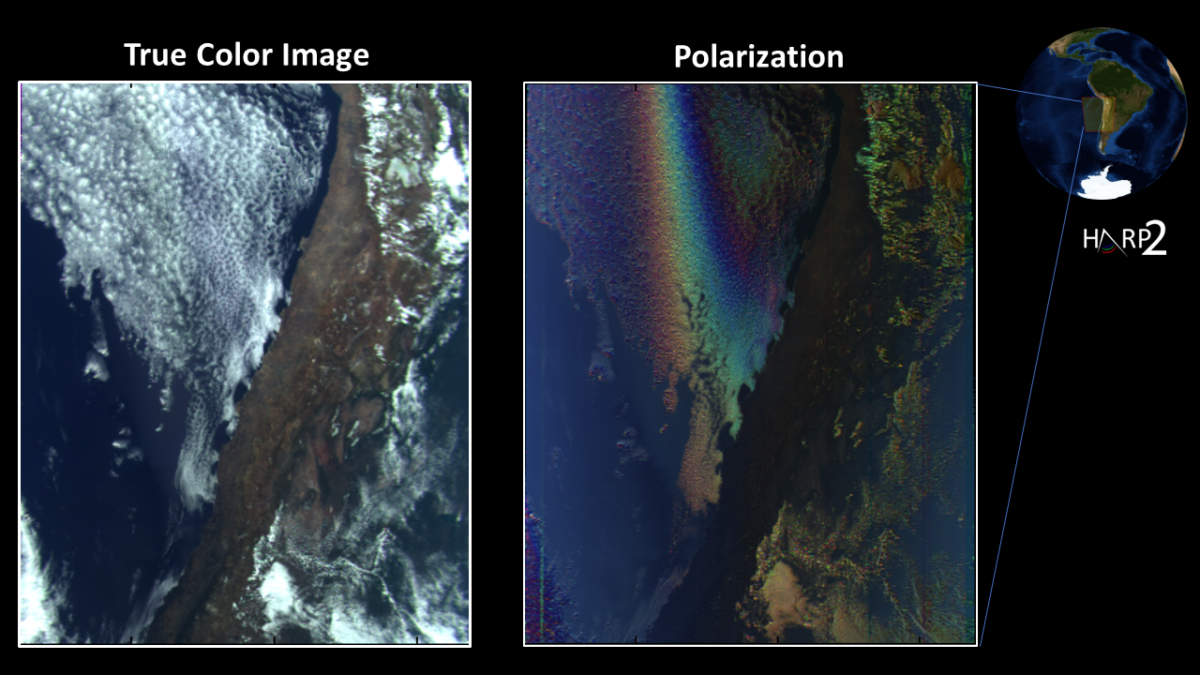
First data from UMBC’s HARP2 instrument on NASA PACE mission goes public
- Perspectives

Bollywood is playing a large supporting role in India’s elections
Search UMBC Search
- Accreditation
- Consumer Information
- Equal Opportunity
- Privacy PDF Download
- Web Accessibility
Search UMBC.edu
share this!
April 15, 2019
Travel through wormholes is possible, but slow
by American Institute of Physics
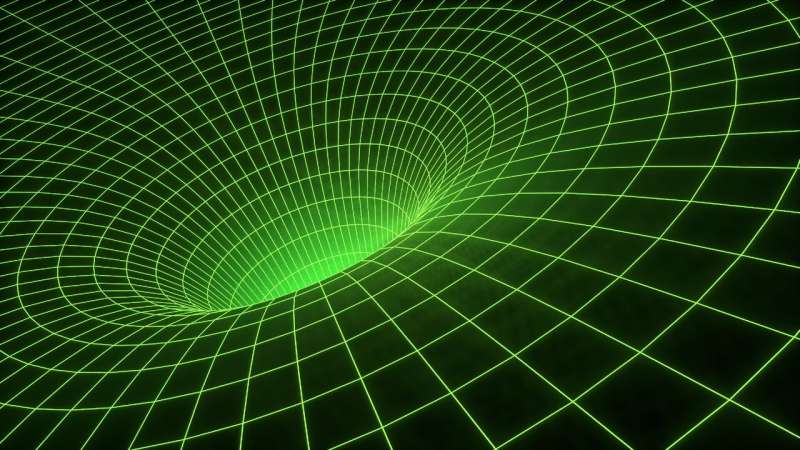
A Harvard physicist has shown that wormholes can exist: tunnels in curved space-time, connecting two distant places, through which travel is possible.
But don't pack your bags for a trip to other side of the galaxy yet; although it's theoretically possible, it's not useful for humans to travel through, said the author of the study, Daniel Jafferis, from Harvard University, written in collaboration with Ping Gao, also from Harvard and Aron Wall from Stanford University.
"It takes longer to get through these wormholes than to go directly, so they are not very useful for space travel ," Jafferis said. He will present his findings at the 2019 American Physical Society April Meeting in Denver.
Despite his pessimism for pan-galactic travel, he said that finding a way to construct a wormhole through which light could travel was a boost in the quest to develop a theory of quantum gravity.
"The real import of this work is in its relation to the black hole information problem and the connections between gravity and quantum mechanics ," Jafferis said.
The new theory was inspired when Jafferis began thinking about two black holes that were entangled on a quantum level, as formulated in the ER=EPR correspondence by Juan Maldacena from the Institute for Advanced Study and Lenny Susskind from Stanford. Although this means the direct connection between the black holes is shorter than the wormhole connection—and therefore the wormhole travel is not a shortcut—the theory gives new insights into quantum mechanics.
"From the outside perspective, travel through the wormhole is equivalent to quantum teleportation using entangled black holes," Jafferis said.
Jafferis based his theory on a setup first devised by Einstein and Rosen in 1935, consisting of a connection between two black holes (the term wormhole was coined in 1957). Because the wormhole is traversable, Jafferis said, it was a special case in which information could be extracted from a black hole.
"It gives a causal probe of regions that would otherwise have been behind a horizon, a window to the experience of an observer inside a spacetime, that is accessible from the outside," said Jafferis.
To date, a major stumbling block in formulating traversable wormholes has been the need for negative energy, which seemed to be inconsistent with quantum gravity. However, Jafferis has overcome this using quantum field theory tools, calculating quantum effects similar to the Casimir effect.
"I think it will teach us deep things about the gauge/gravity correspondence, quantum gravity, and even perhaps a new way to formulate quantum mechanics," Jafferis said.
Provided by American Institute of Physics
Explore further
Feedback to editors

Research team discovers more than 50 potentially new deep-sea species in one of the most unexplored areas of the planet
15 hours ago

New study details how starving cells hijack protein transport stations

New species of ant found pottering under the Pilbara named after Voldemort
16 hours ago

Searching for new asymmetry between matter and antimatter

Where have all the right whales gone? Researchers map population density to make predictions

Exoplanets true to size: New model calculations shows impact of star's brightness and magnetic activity
17 hours ago

Decoding the language of cells: Profiling the proteins behind cellular organelle communication

A new type of seismic sensor to detect moonquakes


Macroalgae genetics study sheds light on how seaweed became multicellular
18 hours ago

Africa's iconic flamingos threatened by rising lake levels, study shows
Relevant physicsforums posts, could you use the moon to reflect sunlight onto a solar sail.
Apr 8, 2024
Biot Savart law gives us magnetic field strength or magnetic flux density?
Apr 6, 2024
Why charge density of moving dipole is dependent on time?
Apr 5, 2024
I have a question about energy & ignoring friction losses
Apr 3, 2024
What Causes the Einstein - de Haas Effect in Iron Rods?
Mar 31, 2024
Effects of the centre of gravity on aircraft's stability
Mar 30, 2024
More from Other Physics Topics
Related Stories

Scientists dismiss the idea of travel through wormholes
Dec 14, 2018

Physicist describes the shape of a wormhole
Oct 17, 2018

'Spooky action' builds a wormhole between 'entangled' quantum particles
Dec 3, 2013
Escaping gravity's clutches: The black hole breakout
Aug 11, 2011

Creation of entanglement simultaneously gives rise to a wormhole
Dec 5, 2013

Listening to quantum radio
Mar 8, 2019
Recommended for you

Evidence of a new subatomic particle observed
19 hours ago

Trapped in the middle: Billiards with memory framework leads to mathematical questions
Apr 11, 2024

ATLAS provides first measurement of the W-boson width at the LHC
Apr 10, 2024

Peter Higgs, physicist who proposed the existence of the 'God particle,' dies at 94
Apr 9, 2024

FASER measures high-energy neutrino interaction strength
Let us know if there is a problem with our content.
Use this form if you have come across a typo, inaccuracy or would like to send an edit request for the content on this page. For general inquiries, please use our contact form . For general feedback, use the public comments section below (please adhere to guidelines ).
Please select the most appropriate category to facilitate processing of your request
Thank you for taking time to provide your feedback to the editors.
Your feedback is important to us. However, we do not guarantee individual replies due to the high volume of messages.
E-mail the story
Your email address is used only to let the recipient know who sent the email. Neither your address nor the recipient's address will be used for any other purpose. The information you enter will appear in your e-mail message and is not retained by Phys.org in any form.
Newsletter sign up
Get weekly and/or daily updates delivered to your inbox. You can unsubscribe at any time and we'll never share your details to third parties.
More information Privacy policy
Donate and enjoy an ad-free experience
We keep our content available to everyone. Consider supporting Science X's mission by getting a premium account.
E-mail newsletter
Traversable wormholes are possible under certain gravity conditions
If you want to come back from a trip through a wormhole, you'll need some weird gravity.

Interested in scooting through a wormhole, the ultimate cheat-code through space and time? Perhaps you'd like to hop from star system to star system across the universe without breaking a sweat? But first, you'd better make sure your wormhole is traversable.
"Any traveler trying to cross a wormhole that does not satisfy this will be crushed inside as the tunnel collapses," João Rosa, a physicist at University of Tartu, in Estonia, told Live Science.
Rosa is attempting to virtually "build" a stable, traversable wormhole, one that can be safely crossed without the theoretical passageway collapsing or trapping its occupant. And he has recently found that it is indeed possible, but only if we tweak our understanding of gravity .
Related: Physicists just released step-by-step instructions for building a wormhole
The problem of traversability
Wormholes are deceptively easy to build — on paper. You start with a theory of gravity. In Einstein's theory of general relativity , gravity defines the relationship between matter and energy, and space and time. The trick to building a wormhole is to find a configuration of matter and energy that allows you to form a tunnel — usually called a "throat" in wormhole research — bridging two distant points in space.
In principle, that throat can be as long or as short as you want, but the more interesting wormholes happen when the throat is far shorter than the normal distance between two points, making the wormhole a convenient shortcut. Oh, and wormholes can also act as time machines, sending you into the future or past, depending on how they're constructed.
The idea of such a whimsical shortcut has captured the imaginations of scientists and science-fiction writers for decades.
Sign up for the Live Science daily newsletter now
Get the world’s most fascinating discoveries delivered straight to your inbox.
"The possibility to visit other stars (or even other galaxies), possibly finding alien civilizations, and the possibility to revisit the past or not having to wait for the future have been part of the human imagination and fantasy for a long time, and wormholes provide a (relatively) simple and unified solution for both of these problems," Rosa told Live Science in an email.
But wormholes constructed based on the criteria laid out by general relativity suffer a major problem: They're not actually traversable. The entrances of general relativity wormholes are hidden behind event horizons, which are one-way barriers in space. That means if you were to enter the wormhole, you could never leave, which would defeat the purpose.
The other problem is that they are ridiculously unstable. The moment even a single photon, or light particle, enters the throat, the whole wormhole catastrophically collapses before that packet of light can escape.
Bummer.
A new gravity
In order to solve these problems in general relativity and stabilize a wormhole, a cosmic traveler must fashion the wormhole out of an incredibly exotic ingredient, a form of matter that has negative energy or negative mass. Negative mass (also known as exotic matter) is exactly what it sounds like: If something weighs negative 10 pounds, it would have negative mass. Scientists have not observed negative mass anywhere in the universe. Negative energy is slightly more attainable, which is just a condition where the energy in a particular location is negative relative to its surroundings, but that can only be achieved at microscopic, quantum scales.
Related: 8 ways you can see Einstein's theory of relativity in real life
"What happens is that these gravitational effects needed to guarantee the traversability of the wormhole happen naturally if one modifies gravity." João Rosa
"The presence of this matter is essential as it prevents the wormhole throat from collapsing upon a traveler, but it is also problematic," Rosa explained. "It presents a negative average energy density, an extremely rare characteristic of matter in the universe that is only observed in very specific situations at the quantum level."
Since such matter is so rare, building an entire wormhole out of the exotic matter would seem impossible in our universe.
But all this talk about wormholes is predicated on general relativity. And while that theory of gravity has survived every single observational and experimental test thrown at it over the last century, we know that general relativity isn't the last word on gravity. Relativity is incapable of describing the centers of black holes , the earliest moments of the universe and the link between itself and quantum physics.
So maybe a new, improved theory of gravity would allow wormholes to exist.
Making the trip
That's exactly what Rosa investigated in a new paper published online July 29 to the preprint journal arXiv , meaning the study has yet to be reviewed by peers in the field.
Rosa employed a tweaked form of gravity called generalized hybrid metric-Palatini gravity. This theory of gravity is built on general relativity, but allows more flexibility in relationships between matter and energy, and space and time.
Earlier research had found that traversable wormholes might be possible in this modified theory of gravity, but they still required negative energy outside the wormhole throat. Rosa found that by layering the entrances to the wormholes with double thin shells of regular matter, the wormhole becomes traversable without any negative energy.
Related: Science fact or fiction? The plausibility of 10 sci-fi concepts
"What happens is that these gravitational effects needed to guarantee the traversability of the wormhole happen naturally if one modifies gravity, and exotic matter [matter with negative mass] is no longer needed to serve this purpose," Rosa explained.
What's next? Rosa wants to test this particular theory of modified gravity. "This is just a very small step towards the final goal: One must now use experimental data and observations (e.g. gravitational waves and trajectories of stars near the center of the Milky Way ) to test and (hopefully) confirm the validity of these theories," Rosa wrote.
— Interstellar space travel: 7 futuristic spacecraft to explore the cosmos — Stephen Hawking's most far-out ideas about black holes — 10 wild theories about the universe
While general relativity has so far explained all measurements of gravity (including gravitational waves and the vicinity of black holes), the story isn't over. Future observations might find a crack in that venerable theory, and if generalized hybrid metric-Palatini gravity better explains cosmic observations, then wormholes made for travel might be possible.
But the questions wouldn't end there. Wormholes can also act as time machines, so a viable wormhole solution would mean that time travel into the past is possible; that, of course, raises all sorts of difficult problems (like the so-called " grandfather paradox " and questions about causality). Knowing for sure that traversable wormholes could exist wouldn't just make our sci-fi dreams come true, it would totally upend our understanding of physics.
Originally published on Live Science.

Paul M. Sutter is a research professor in astrophysics at SUNY Stony Brook University and the Flatiron Institute in New York City. He regularly appears on TV and podcasts, including "Ask a Spaceman." He is the author of two books, "Your Place in the Universe" and "How to Die in Space," and is a regular contributor to Space.com, Live Science, and more. Paul received his PhD in Physics from the University of Illinois at Urbana-Champaign in 2011, and spent three years at the Paris Institute of Astrophysics, followed by a research fellowship in Trieste, Italy.
Elusive Planet Nine could be an alternative form of gravity masquerading as a planet, study claims
Major CERN experiment proves antigravity doesn't exist — at least when it comes to antimatter
Why I watched the solar eclipse with my kids, a goose and 2,000 trees
Most Popular
By Peter Ray Allison April 10, 2024
By Tom Metcalfe April 09, 2024
By Rebecca Sohn April 09, 2024
By Stephanie Pappas April 09, 2024
By Samantha Mathewson April 09, 2024
By Nicoletta Lanese April 09, 2024
By Sascha Pare April 09, 2024
By Emily Cooke April 09, 2024
By Harry Baker April 09, 2024
- 2 Watch live! The total solar eclipse has begun over North America.
- 3 8,200-year-old campsite of 'Paleo-Archaic' peoples discovered on US Air Force base in New Mexico
- 4 Eclipse from space: See the moon's shadow race across North America at 1,500 mph in epic satellite footage
- 5 NASA engineers discover why Voyager 1 is sending a stream of gibberish from outside our solar system
- 2 Part of the San Andreas fault may be gearing up for an earthquake
- 3 Extremely rare marsupial mole that 'expertly navigates' sand dunes spotted in Western Australia
- 4 Giant 'toe biter' water bugs discovered in Cyprus for the 1st time
- 5 Low tides reveal Bronze Age fortress that likely defended against Irish mainland
How to time travel with wormholes
Brian Greene , professor of physics and mathematics at Columbia University and co-founder of the World Science Festival , explains what we know about time travel so far. Following is a transcript of the video.
Brian Greene: I’m Brian Greene, professor of physics and mathematics at Columbia University and co-founder of the World Science Festival.
It's critical that you realize that there are two types of time travel , and they are radically different. Time travel to the future? Definitely possible.
We know how to do it because Einstein showed us the way over a hundred years ago. It’s surprising how few people actually really know about this in their bones. He showed that if you go out into space and travel near the speed of light, and you turn around, and you come back, your clock will be ticking off time more slowly. So, when you step off it's going to be the future on planet Earth. You will have time traveled into the future.
He also showed that if you hang out near a nice strong source of gravity — a neutron star, a black hole — and you kind of get right near the edge of that object, time also for you would slow down real slow relative to everybody else. And therefore, when you come back to Earth, for instance, it'll again be far into the future.
This is not controversial stuff. Any physicist who knows what they're talking about agrees with this. But the other kind of time travel — to the past is where the arguments start to happen because many of us don't think that time travel to the past is possible.
The main proposal that people at least consider worthy of attention for traveling to the past does make use of a weird concept called wormholes . A wormhole is something that really … Albert Einstein again discovered. The guy has like got his name written over everything in this field.
It's a bridge, if you will, from one location space to another. It's kind of a tunnel that gives you a shortcut to go from here to here. Now he discovered this in 1935 but it was subsequently realized that if you manipulate the openings of a wormhole — put one near a black hole or take one on a high-speed journey — then time of the two openings of this wormhole tunnel will not take off at the same rate, so that you will no longer just go from one location in space to another, if you go through this tunnel — through this wormhole — you'll go from one moment in time to a different moment in time. Go one way, you'll travel to the past, the other way, travel to the future.
Now again, we don't know if wormholes are real. We don't know if they are real whether you'll be able to go through them. So, there are all sorts of uncertainties here. Most of us think that you're not going to actually go on a whirlwind journey through a wormhole to the past. But it's still not ruled out.
More from Science
- Main content
February 2, 2017
Are Wormholes a Dead End for Faster-Than-Light Travel?
Portals connecting far-distant regions of the universe may not be just the stuff of science fiction, but they probably couldn't be used for interstellar travel
By Paul Sutter & SPACE.com
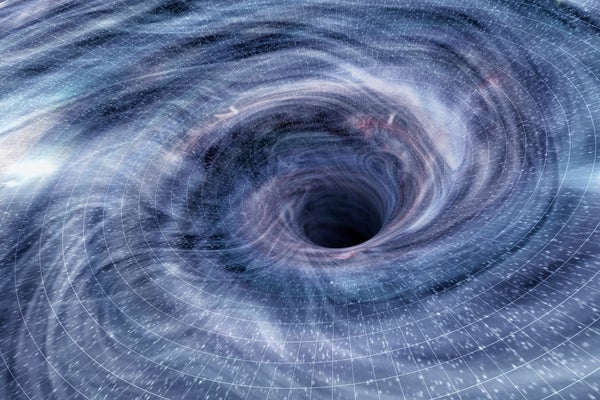
Science Photo Library Getty Images
Ah, wormholes. The intergalactic shortcut. A tunnel through space-time that allows intrepid travelers to hop from star system to star system without ever coming close to the speed of light.
Wormholes are a workhorse of sci-fi interstellar civilizations in books and on the screen because they solve the annoying problem of "Well, if we stuck to known physics, 99.99999 percent of the story would be as fascinating as watching people sleep."
But could we do it? Could we actually warp and bend space-time to make a convenient tunnel, making all of our galactic dreams come true? [ Weird Science: Wormholes Make the Best Time Machines ]
On supporting science journalism
If you're enjoying this article, consider supporting our award-winning journalism by subscribing . By purchasing a subscription you are helping to ensure the future of impactful stories about the discoveries and ideas shaping our world today.
Short answer: not likely.
Long answer: Well, keep reading.
Beware the white hole
The concept of wormholes got its start when physicist Ludwig Flamm, and later Albert Einstein and Nathan Rosen, realized that black holes can be "extended." When one goes about solving the fantastically complicated equations of general relativity , the machinery that predicts a black hole also predicts a phenomenon called a white hole. A white hole is pretty much what you think: Whereas a black hole's event horizon marks a region of space that once you enter you can't leave, it's impossible to enter a white hole's horizon, although anything already in there can escape.
That same mathematical machinery delivers a bonus, too: All black holes would be naturally "connected" to white holes via their singularities, making a tunnel through space. Woohoo, wormholes here we go!
Or not. While we have gobs of evidence for the existence of black holes, white holes appear to be mathematical fiction. There's no known process in our universe that would actually form them, and even if they did pop into existence, their natural extreme instability would snuff them right out again. [ Watch: Wormhole instabilities. ]
Oh, yeah, and the mechanism for making black holes the collapse of massive stars —also automatically prevents the formation of a symbiotic white hole.
And even if they did form (and they don't), the extreme gravity of the mutual singularities would cause the wormhole tunnel to immediately stretch and snap much more quickly than anything could cross it.
Death by wormhole
But that doesn't stop anybody from playing a fun game of "what if." What if white holes could naturally form, or be constructed? What if we could stabilize them? What if we could attach a white hole's singularity to a black hole and make a wormhole? What if? What if? What if?
Well, for one thing, traveling down such a wormhole would really, really suck. Literally. The entrance to the wormhole—the "throat"—sits inside the event horizon of the black hole.
That's a problem.
The very definition of an event horizon—their very cosmique raison d'etre — is that once you enter them, you don't get to come out. No way, no how. It doesn't matter if there's a wormhole tunnel inside it—you don't get to leave.
Inside a black hole event horizon, you have only one destination: singularity town, the place of infinite density and soul-crushing gravitational forces.
So let's say you enter a wormhole. You can watch light from another patch of the universe filter in from the opposite side. If someone else jumps in, you can meet them and have some tea together. And you can die—miserably—as you careen into the singularity. [ Chasing Wormholes: The Hunt for Tunnels in Space-Time ]
Positively negative
Is there any way to make a working, even fun, wormhole, instead of a terrifying portal to inevitable destruction?
Surprisingly, yes. Well, not quite 100 percent absolutely "this is a normal part of our universe" yes. More like "if we play pretend" yes.
To construct a traversable wormhole, you need to overcome two important obstacles. First, the entrance to the wormhole has to actually sit outside the event horizon. That would allow you to enter the wormhole and blast through it to your faraway destination without fearing a "singular" encounter.
Second, the tunnel itself has to be stable and strong. It has to withstand the extreme gravity of the singularities and resist tearing apart when something flies down its length.
There is indeed a material that solves both problems. But that material has a problem all its own: It has negative mass.
That's right: mass, but negative. A ring of negative-mass material could be used to construct a fully functional and useful wormhole. Since the exotic nature of negative mass warps spacetime in a unique way, it "inflates" the entrance to the wormhole outside the boundary of the event horizon, and stabilizes the throat of the wormhole against instabilities. It’s not an intuitive result but the math checks out.
But could such a substance exist? We've mapped out a good chunk of the universe, and we've never seen negative mass. If it did exist, it would have some pretty weird properties. For example, following the math of Newton’s Laws with some minus signs tossed in, we find that a negative-mass particle would push on a positive-mass particle, while the positive-mass particle would pull on the negative-mass one. Set two opposite-mass particles next to each other, perfectly still, and the pair would start accelerating, zooming off without any input of force.
That seems like that might violate some sort of rule. [ Watch: The problem of negative mass. ]
What about the Casimir effect , the odd and fascinating attraction of two metal plates due to vacuum energy? That’s often trotted out as an example of the universe behaving badly, and a possible route to negative mass. But the Casimir force is characterized by local negative pressure (it pulls rather than pushes), not negative mass.Sure, we don't know everything there is to know about quantum gravity and the nature of space-time at super-duper-teensy scales. Could an advanced civilization discover the path to negative mass and manipulate gravity in just the right way? Would a breakthrough in physics point a way to fashioning wormholes?
Honestly, probably not. There are just too many things working against them. Working wormholes would violate so many aspects about known (and extremely well tested) physics that I think it's better to just work on other problems.
I know some people might accuse me of not being creative enough, but the universe doesn't care about our creativity. The tools of science are harsh but fair judges; if an idea doesn't work, it simply doesn't work. There are many varied and beautiful mysteries in our universe, and we certainly haven't unlocked all of the inner workings of the cosmos. But wormholes probably aren't one of them.
Learn more by listening to the episode " Wormholes - deal or no deal? " on the Ask A Spaceman podcast, available on iTunes and on the Web at http://www.askaspaceman.com . Thanks to @SkaTaTah and @bretthines61 for the questions that led to this piece! Ask your own question on Twitter using #AskASpaceman or by following Paul @PaulMattSutter and facebook.com/PaulMattSutter .
How Time Travel Works in Science Fiction (Infographic)
Warp Speed: The Hype of Hyperspace
How To Make A Black Hole [And Kayak The Wormhole!] | Video
Copyright 2017 SPACE.com , a Purch company. All rights reserved. This material may not be published, broadcast, rewritten or redistributed.

Wormholes and Time Travel: Science Fiction or Reality?
W ormholes are cosmic tunnels, hypothetical shortcuts through spacetime that connect distant regions of the universe. In the realm of science fiction, they are often portrayed as gateways to other dimensions, alternate realities, or even different points in time. While the concept of wormholes has captured the imagination of writers, filmmakers, and scientists alike, the question remains: could these cosmic portals hold the key to realizing the dream of time travel? In this article, we will embark on a journey through the fascinating world of wormholes, exploring their theoretical underpinnings, scientific plausibility, and potential implications for the future of space exploration and our understanding of the cosmos.
- Theoretical Foundations:
The concept of wormholes arises from the mathematics of general relativity, Albert Einstein’s theory of gravity and spacetime. In the equations of general relativity, wormholes are solutions that describe hypothetical tunnels through the fabric of spacetime, linking two separate points in space and potentially allowing for shortcuts across vast cosmic distances. While wormholes are mathematically permissible within the framework of general relativity, their existence and stability depend on highly speculative conditions and exotic forms of matter with negative energy densities.
- Schwarzschild Wormholes:
The simplest type of wormhole solution in general relativity is known as the Schwarzschild wormhole, named after the German physicist Karl Schwarzschild who first discovered the solution in 1916. Schwarzschild wormholes are static, spherically symmetric tunnels that connect two separate regions of spacetime, similar to a tunnel passing through the center of a black hole. While Schwarzschild wormholes are theoretically possible, they are highly unstable and prone to collapse under the influence of gravitational forces, making them impractical for traversing.
- Morris-Thorne Wormholes:
In the 1980s, physicists Michael Morris and Kip Thorne proposed a modified version of the Schwarzschild wormhole known as the Morris-Thorne wormhole. Unlike Schwarzschild wormholes, which are unstable and subject to gravitational collapse, Morris-Thorne wormholes are stabilized by exotic forms of matter with negative energy densities that counteract the gravitational forces pulling the wormhole closed. While Morris-Thorne wormholes offer a theoretical framework for stable traversable wormholes, the existence of the exotic matter required to stabilize them remains purely speculative.
- Traversable Wormholes and Time Travel:
The concept of traversable wormholes, which allow for the passage of matter and information between two separate points in spacetime, raises intriguing possibilities for time travel. In principle, a traversable wormhole could serve as a cosmic bridge connecting different points in time as well as space, allowing for journeys to the past or future. However, the feasibility of using traversable wormholes for time travel hinges on numerous theoretical and practical challenges, including the stability of the wormhole, the nature of exotic matter, and the avoidance of causality violations and paradoxes.
- The Grandfather Paradox:
One of the most famous paradoxes associated with time travel via wormholes is the Grandfather Paradox, which we explored in the previous article. According to this paradox, a time traveler could potentially alter the past in a way that prevents their own existence, leading to logical inconsistencies and paradoxical outcomes. The existence of the Grandfather Paradox highlights the complex interplay between causality, free will, and the nature of time in the context of time travel.
- Quantum Entanglement and Spacetime:
Recent advances in theoretical physics, particularly in the field of quantum gravity and the study of black holes, have shed new light on the nature of spacetime and the possibility of traversable wormholes. Quantum entanglement, a phenomenon in which particles become correlated in such a way that the state of one particle instantaneously influences the state of another, may play a crucial role in the structure of spacetime and the stability of wormholes. While the connection between quantum entanglement and wormholes remains speculative, it offers tantalizing hints about the underlying quantum nature of spacetime.
- Observational Evidence and Experimental Verification:
Despite the theoretical plausibility of wormholes, observational evidence for their existence remains elusive. While astronomers have observed numerous phenomena that could potentially be associated with wormholes, such as black holes, neutron stars, and gravitational waves, direct evidence for traversable wormholes has yet to be detected. Additionally, the experimental verification of traversable wormholes poses formidable challenges, as they would require the manipulation of exotic matter with negative energy densities—an elusive substance that has yet to be observed or synthesized in the laboratory.
- Ethical and Philosophical Considerations:
The prospect of time travel via wormholes raises profound ethical and philosophical questions about the nature of reality, causality, and the human experience. The ability to travel backward or forward in time could have far-reaching consequences for individuals, societies, and the course of history, raising concerns about the preservation of historical integrity, the prevention of causality violations and paradoxes, and the ethical responsibility of time travelers. As we contemplate the possibility of time travel via wormholes, it is essential to consider the ethical implications of altering the past and the potential risks and benefits associated with such endeavors.
- Future Prospects and Challenges:
While time travel via wormholes remains a speculative and hypothetical concept, ongoing research in theoretical physics, cosmology, and quantum gravity continues to explore the theoretical foundations and practical feasibility of traversable wormholes. Advances in observational astronomy, experimental physics, and computational modeling may one day provide insights into the nature of spacetime and the existence of cosmic shortcuts through the universe. As scientists and philosophers grapple with the mysteries of wormholes and time travel, they are confronted with profound questions about the nature of reality and the limits of human knowledge and imagination.
Conclusion:
Wormholes and time travel represent a tantalizing intersection of scientific speculation, theoretical physics, and science fiction. While the concept of traversable wormholes offers intriguing possibilities for journeying through spacetime and exploring the mysteries of the cosmos, numerous theoretical, practical, and ethical challenges must be overcome before time travel via wormholes becomes a reality. As scientists continue to push the boundaries of our understanding of the universe, they are confronted with profound questions about the nature of time, space, and the human quest for knowledge and exploration. Whether wormholes will remain the stuff of science fiction or become the portals to new realms of discovery and understanding remains an open question—one that continues to inspire curiosity, imagination, and inquiry into the mysteries of the cosmos.
Read More: Will Bitcoin Reach $100K Sooner Than Expected? Chinese Asset Managers and Hong Kong’s Major ETF Push Could Accelerate Growth
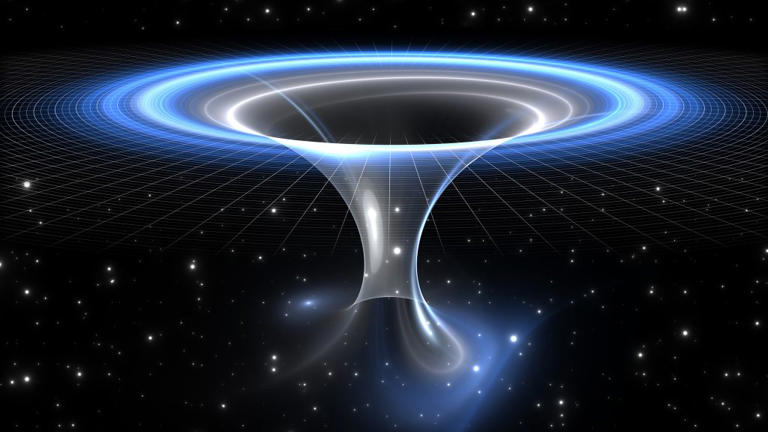
What to Know About the Arizona Supreme Court Abortion Ban Ruling
T he Arizona Supreme Court upheld a 160-year-old abortion ban on Tuesday that would prohibit nearly all abortions in the state except when “necessary to save” a pregnant person’s life.
The decision reversed a previous Arizona Court of Appeals ruling that allowed abortion to remain legal in the state up to 15 weeks, in accordance with a 2022 law, according to Planned Parenthood .
“Make no mistake, by effectively striking down a law passed this century and replacing it with one from 160 years ago, the Court has risked the health and lives of Arizonans,” said Arizona Attorney General Kris Mayes in a press statement Tuesday, before adding that her office would not be prosecuting any physician or woman under the “draconian law.”
The near-total abortion ban was written before Arizona was officially a state and before women could vote. The ban, which dates back to 1864, would sentence abortion providers to two to five years in prison for providing an abortion. Additional sanctions could be issued to physicians who perform abortions after 15 weeks.
The ban won’t go into effect just yet—as the court stayed its enforcement for 14 days.
“Arizonans deserve the right to make personal decisions about their reproductive health care, free from government interference. We are devastated by today’s ruling but we remain committed to defending reproductive freedom in the courts, at the legislature, as well as in communities across the state towards the passage of the Arizona for Abortion Access Act this November,” said Jared Keenan, legal director of the ACLU of Arizona, in a press release . “The urgency to enshrine the right to abortion in our state’s constitution has never been more necessary.”
What the Arizona Supreme Court decision says
The Arizona Supreme Court decision would make it so that “all abortions, except those necessary to save a woman’s life, are illegal,” according to the ruling. There are no exceptions for rape and incest.
“We conclude that [Arizona’s law] does not create a right to, or otherwise provide independent statutory authority for, an abortion that repeals or restricts [the law], but rather is predicated entirely on the existence of a federal constitutional right to an abortion since disclaimed by Dobbs v. Jackson Women’s Health Organization,” the court said in its opinion. “Absent the federal constitutional abortion right, and because [the law] does not independently authorize abortion, there is no provision in federal or state law prohibiting [the law’s] operation. Accordingly, [Arizona’s law] is now enforceable. ”
The act has been criticized by several politicians, including the president. “Millions of Arizonans will soon live under an even more extreme and dangerous abortion ban, which fails to protect women even when their health is at risk or in tragic cases of rape or incest,” President Biden said in a Tuesday press release .
What does it mean for women and abortion providers?
Planned Parenthood says that abortion through 15 weeks will remain accessible “for a limited period of time” because of a separate lawsuit filed in October 2022. In that case, the Maricopa County Superior Court ruled that the state cannot enforce the abortion ban until 45 days after the Arizona Supreme Court made a decision, per Planned Parenthood . That means the ban would not go into effect until June.
“This decision will result in a legal chilling effect on Arizonans who wish to obtain abortion services regardless of the circumstances that lead to their decision, and for those in the medical community who might provide them,” said Pima County Attorney Laura Conover, a party in the case in an emailed statement.“The result of this will ultimately cause an increase in unsafe abortions and threaten the liberties of those involved because the criminalization of abortions will not end the need or desire of those who seek services.”
Will there be a ballot initiative?
Arizona for Abortion Access, made up of a number of reproductive rights organizations, is pushing for a constitutional amendment that would give a right to abortion care until fetal viability, or the 24th week of pregnancy. Abortions would be provided after that point if a health care provider says an abortion is necessary to “protect the life or the physical or mental health of the pregnant individual,” under the ballot initiative .
Arizona abortion advocates need to get 384,000 valid signatures by July 3 if they want to put abortion on the ballot this November. Organizers said they exceeded the signature threshold by more than 100,000, but have a goal of 800,000, according to NBC News . The signatures still have to be certified.
More Must-Reads From TIME
- Exclusive: Google Workers Revolt Over $1.2 Billion Contract With Israel
- Jane Fonda Champions Climate Action for Every Generation
- Stop Looking for Your Forever Home
- The Sympathizer Counters 50 Years of Hollywood Vietnam War Narratives
- The Bliss of Seeing the Eclipse From Cleveland
- Hormonal Birth Control Doesn’t Deserve Its Bad Reputation
- The Best TV Shows to Watch on Peacock
- Want Weekly Recs on What to Watch, Read, and More? Sign Up for Worth Your Time
Contact us at [email protected]
- Skip to main content
- Keyboard shortcuts for audio player

Solar eclipse 2024: Follow the path of totality
Solar eclipse, what you need to know to watch monday's total solar eclipse.
The NPR Network
A stunning celestial event is visible across the country Monday, when the moon crosses directly in front of the sun: a total solar eclipse. For those in the path of totality, there will be a few brief moments when the moon completely covers the sun and the world becomes dark.
Traveling for totality? Skip ahead.
This will be the last chance to catch a total solar eclipse in the continental U.S. for about 20 years, so here's what you need to know to safely enjoy!
When is the eclipse?
April 8, 2024 there will be a total solar eclipse that crosses from the Pacific coast of Mexico through the United States.
What is totality and why it matters
According to NASA , totality will start around 11:07 a.m. PDT/1:07 EDT in Mexico and leave Maine at around 1:30 pm PDT/3:30 pm EDT.

Here's what time the eclipse will be visible in your region
Check out this table for when the partial eclipse and totality are visible in each region or check by zip code here.
A partial solar eclipse will be visible across the contiguous United States, so even if you're not directly in the path, you should be able to see something special, weather permitting.
Unable to get to totality? We'll be sharing highlights here from across the NPR Network throughout the day Monday if you can't see it in real time.
Where to see totality?
More than 30 million people live in the path of totality for Monday's eclipse, and many more in nearby areas.
Here's what we know about Monday's weather forecast.
Why totality matters
As NPR's Neil Greenfieldboyce explains , "During a total eclipse, the sky darkens suddenly and dramatically . The temperature drops. Stars come out. Beautiful colors appear around the horizon. And the once-familiar sun becomes a black void in the sky surrounded by the glowing corona — that's the ghostly white ring that is the sun's atmosphere."

Eclipse Science
For april's eclipse, going from 'meh' to 'omg' might mean just driving across town.
A partial eclipse, while still a fun experience, is hardly as dramatic. Those with a view of the partial eclipse will see crescent-shaped shadows like those seen here in 2017.
How to watch safely
If you plan to look directly at the eclipse (partial or totality), you're going to need eclipse glasses handy because looking directly at the sun without proper protection ( traditional sunglasses don't count! ) can be harmful to your eyes.

The perfect celestial soundtrack to the total solar eclipse
As NPR's Joe Hernandez explains, "Proper eye protection must be worn throughout a total solar eclipse — except for the roughly 3 1/2 to 4 minutes when the moon fully obscures the sun, a brief period known as 'totality.' (You will need to take your glasses off during totality to actually see it.)"
If you don't have access to eclipse glasses, you can get crafty with things you have around the house ( like some of us did back in 2017!) More on that here.
Traveling for totality?
The celestial event is driving a ton of domestic travel to the path of totality. If you're headed out of town to view the eclipse, here are some NPR Network resources for areas in the path of totality:
Texas The path of totality crosses through the Lone Star State, with some areas expecting a possible influx of visitors in the hundreds of thousands to catch prime viewing. Our member stations across the state have gathered local resources to help you navigate the region and the eclipse!
- San Antonio: Check out the latest from Texas Public Radio
- Dallas: Explore KERA's coverage for the latest
- Austin: Head to KUT for the best local resources
Arkansas The eclipse will be cutting through the state, putting Little Rock in the path of totality. Check out Little Rock Public Radio for local resources.
The southwestern edge of the state will be well-positioned to witness the total solar eclipse this year. Kentucky Public Radio is covering the eclipse throughout the region, from Kentuckiana eclipse mania to the University of Louisville's free class about the celestial event. Keep an eye on WKMS for the latest local updates.
Missouri The southeastern corner of the state will be in the path of totality, crossing across towns like Whitewater and Ste. Genevieve. Head to St. Louis Public Radio for local coverage and resources. Illinois Carbondale seems to have won the eclipse lottery, being in the path of totality both in 2017 and for this year's eclipse . For resources from across the state, check out Illinois Public Media .
Indiana A huge portion of the state will be within the path of totality, giving cities across Indiana, including Bloomington and Indianapolis, prime viewing of the eclipse.
- Bloomington: Check out Indiana Public Media
- Indianapolis: Head to WFYI for the latest
- Fort Wayne: Just north of the path of totality, WBOI has resources for the Allen County area
Ohio The Buckeye State is getting bisected by this year's path of totality, plunging a number of the state's most populous areas into darkness for a few minutes on Monday.
- Cleveland: Head to Ideastream Public Media for the latest.
- Columbus: With the capital city just south of totality, head to WOSU for regional resources.
- Cincinnati: Totality will just miss the border town. Here are some tips from WVXU on how to navigate the eclipse in the region.
Pennsylvania Only the northwestern-most corner of the state will catch totality, with views from the lakeside in Erie being particularly well-positioned for a stunning viewing experience. WESA has more from across the region.

Plan to watch the eclipse from a wild mountain summit? Be ready for harsh conditions
New York Buffalo, Rochester, Syracuse and Plattsburgh will fall under the path of totality on Monday. If you're planning to travel to the region for the best views, here are some local resources to stay safe and informed:
- Buffalo: Head to WBFO for the latest
- Syracuse: WAER has more on plans in the Salt City
- North Country: NCPR has the latest from across the region, as well as information on local viewing events to check out
Vermont The Green Mountain State will see totality across its most populous region, including Burlington and Montpelier, as well as the Northeast Kingdom on the Canadian border. Vermont Public has everything you need to know to navigate your time in the region to enjoy the eclipse safely. New Hampshire The northernmost region of the Granite State will be in the path of totality, providing prime viewing to those in Coos County. NHPR has info on local events, travel updates as well as special coverage with New Hampshire Public Television. Maine The last state in the path of totality in the U.S., much of Northern Maine will be positioned for prime viewing. The rural region is preparing for an influx of visitors, and safety officials are encouraging visitors and locals alike to be prepared. Maine Public will be covering the eclipse and has everything you need to know to navigate the region safely.
How to document the eclipse safely
With the ease of cell photography , it can be tempting to reach for your phone to document the eclipse and the moments of totality, but make sure to do so safely.
As NPR's Scott Neuman explains , "For starters, you'll need to wear eclipse glasses or similar protective eye gear while aiming your camera or even just observing the eclipse."
Feeling ambitious? Here are a few more tips.
Or if you're not inclined to capture the moment visually, you lean into some other forms of creative expression. Indiana, for example, has named Linda Neal Reising the official poet in the state for this year's eclipse.
As former NPR reporter and eclipse superfan David Baron shared with Life Kit , viewing totality "[is] like you've left the solar system and are looking back from some other world."
So consider focusing on being present in the moment to enjoy the celestial spectacle.
More resources to enjoy the eclipse
- Sharing the eclipse with tiny humans? Check out these kid-friendly total solar eclipse learning guides from Vermont Public's But Why, and this great explainer from KERA Kids on the difference between a solar and a lunar eclipse.
- Want to see how a solar eclipse alters colors? Wear red and green on Monday
- Plan to wander into the wild for the best view? Here are some tips from outdoor experts.
- Tips from Bill Nye on the best ways to enjoy the eclipse.
NPR will be sharing highlights here from across the NPR Network throughout the day Monday if you're unable to get out and see it in real time. NPR's Emily Alfin Johnson compiled these resources.
- 2024 eclipse

IMAGES
VIDEO
COMMENTS
Physicists Just Figured Out How Wormholes Could Enable Time Travel. Physics 16 July 2023. By Mike McRae. (gremlin/Getty Images) Theoretical physicists have a lot in common with lawyers. Both spend a lot of time looking for loopholes and inconsistencies in the rules that might be exploited somehow. Valeri P. Frolov and Andrei Zelnikov from the ...
Wormhole travel as envisioned by Les Bossinas for NASA, c. 1998. The impossibility of faster-than-light relative speed applies only locally. Wormholes might allow effective superluminal (faster-than-light) travel by ensuring that the speed of light is not exceeded locally at any time. While traveling through a wormhole, subluminal (slower-than ...
Wormholes also have the somewhat mystical ability to allow backwards time travel. If you take one end of the wormhole and accelerate it to a speed close to that of light, it will experience time dilation — its internal "clock" will run slower than the rest of the universe. That will cause the two ends of the wormhole to no longer be ...
Well, yes, you can! You just never saw a game that extreme before. Time-travel research is like that. We're testing the laws of physics by looking at extreme conditions. There's nothing logically ...
Because wormholes represent shortcuts through space-time, they could even act like time machines. You might emerge from one end of a wormhole at a time earlier than when you entered its other end ...
For decades, Scientists have pondered the conundrum of time travel -- debating whether or not it is even possible in our reality. However, research now points to the possibility of a wormhole, a ...
Some scientists are exploring other ideas that could theoretically allow time travel. One concept involves wormholes , or hypothetical tunnels in space that could create shortcuts for journeys ...
Wormholes, thus, are the perfect way to bypass Einstein's speed limit, and get your heroes and villains to travel the galaxy in a reasonable time frame. Plus, they allow for the element of time ...
According to this conjecture, quantum effects will conspire to effectively prevent time travel even when it looks like classical physics might allow time travel to occur. Euclidean wormholes are ...
In 2015 Italian researchers suggested there could be a wormhole lurking in the center of the Milky Way some 27,000 light-years away. Ordinarily, a wormhole would need some exotic matter to keep it ...
Time traveling to the near future is easy: you're doing it right now at a rate of one second per second, and physicists say that rate can change. According to Einstein's special theory of ...
Science fiction wormholes (used to travel in time or faster than light) Science fiction wormhole: travel time is shorter than d. àwould allow faster than light travel, or travel to the past. (speed of light =1) d (Travel time as seen by somebody that remains outside)
A recent study claims to have calculated a potential method of time travel. It involves a highly theoretical object called a "ring wormhole," which is a type of wormhole that connects two ...
A wormhole would allow a ship, for instance, to travel from one point to another faster than the speed of light — sort of. That's because the ship would arrive at its destination sooner than a ...
Time travel through a wormhole is technically feasible under the rules of theoretical physics—the only catch is that we can only ever go backward. ... "should allow for a traversable wormhole."
Time isn't the same everywhere. Some scientists are exploring other ideas that could theoretically allow time travel. One concept involves wormholes, or hypothetical tunnels in space that could create shortcuts for journeys across the universe.If someone could build a wormhole and then figure out a way to move one end at close to the speed of light - like the hypothetical spaceship ...
Credit: CC0 Public Domain. A Harvard physicist has shown that wormholes can exist: tunnels in curved space-time, connecting two distant places, through which travel is possible. But don't pack ...
The best help for time travel is wormholes. If you want to travel from point A to point B on a napkin, for example, you could cross the whole distance or fold the napkin in half, bringing the two points directly adjacent. Wormholes are tunnels in space connecting distant points, which could be used by some crazy advanced civilization, if they ...
Wormholes can also act as time machines, so a viable wormhole solution would mean that time travel into the past is possible; that, of course, raises all sorts of difficult problems (like the so ...
Now he discovered this in 1935 but it was subsequently realized that if you manipulate the openings of a wormhole — put one near a black hole or take one on a high-speed journey — then time of ...
Relativity means it is possible to travel into the future. We don't even need a time machine, exactly. We need to either travel at speeds close to the speed of light, or spend time in an intense ...
The intergalactic shortcut. A tunnel through space-time that allows intrepid travelers to hop from star system to star system without ever coming close to the speed of light. Wormholes are a ...
Let's say a wormhole opens up in your living room, connecting you to a habitable planet in the Andromeda galaxy. You step through, and successfully travel backwards in time, because technically you are much, much further away from the sun now. Oh, and shock factor, the wormhole slams shut. A few years pass, and a new wormhole opens up in your ...
The concept of traversable wormholes, which allow for the passage of matter and information between two separate points in spacetime, raises intriguing possibilities for time travel.
A total solar eclipse created a celestial spectacle Monday in the skies over parts of Mexico, the United States and Canada after a nearly seven-year wait.
The Arizona Supreme Court upheld a 160-year-old abortion ban on Tuesday that would prohibit nearly all abortions in the state except when "necessary to save" a pregnant person's life.
Over 30 million people will be within the path of totality for Monday's solar eclipse as it crosses the U.S. from Texas to Maine. Here's what you need to know to safely enjoy the celestial spectacle.